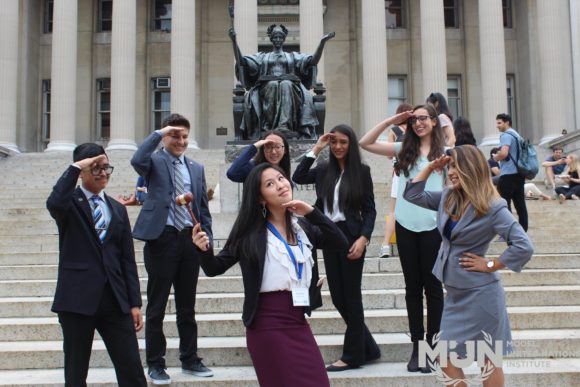
When I signed up for Best Delegate’s Model United Nations Institute in 2015, I hadn’t the faintest idea what to expect. At the time, Model UN was foreign to me, a nerdy eighth grader with an odd interest in international affairs. The public middle school of my Philadelphia suburb had no Model UN team to join, so I figured that a summer program was the next best thing.
Arriving at Georgetown University on a hot afternoon, I was excited to learn about the world of MUN. I knew nothing of parliamentary procedure, resolutions, or position papers at the time, but I knew the capital of Bolivia, and to me, that was enough. The week I spent in the Junior Diplomat program turned out to be a whirlwind, making new friends, submitting position papers at 9:57pm, and experiencing residential life with a caffeine-infused roommate. Needless to say, it was over much too soon.
That fall, I encountered a problem. The first day of school had arrived and many teachers wanted to get to know their new students. They all asked with a slightly different phrasing each time: “What did you do this summer?”
In my town, almost nobody had ever heard of Model UN. In fact, a majority did not know much about the real United Nations. Summers were most often spent in some combination of beach houses and theme parks, not in Georgetown dorm rooms or lecture halls full of placards. My peers could not understand why anyone would choose to spend his summer writing essays and discussing how to prevent radicalization among middle-eastern youth. When I tried to explain any of it, I was met by the same response from friends and teachers alike.
“Model UN? What’s that?”
Each attempt to elaborate only confused them further. After all, a middle school student like me had no business representing Pakistan in a discussion about food security, right? Why would I be in committee when I could have been relaxing at the beach? Despite their disbelief, I held my ground, shooting down any misconceptions that violated my territorial sovereignty.
“No, we don’t work at the UN headquarters.”
“No, I was not allowed to nuke anyone.”
“No, I did not ‘solve’ ISIS.”
Slowly, my friends came to understand my passion for Model UN. They knew that I was following the search for a new Secretary-General more closely than the 2016 Presidential Race. They understood that I suddenly cared much more about what “Western Business Attire” I would wear. They also began to assume that any group messages I received came from MUN Institute alumni in another country or hemisphere. Finally, I was finished with my crusade, and my friends would be confused by MUN no more. Almost.
In the summer of 2016, when I attended the MUN Institute’s Crisis program at Harvard, and it became harder to explain how Model UN works. By the nature of crisis committees, my stories got increasingly complex and intricate. Soon, I had to explain that I had not actually ordered a drone strike on Russian forces in Ukraine and that I had not actually saved four of my fellow cabinet members from anti-government forces in Ankara. The idea of a simulated crisis (i.e. not real, fake, or any number of other synonyms I had to come up with) seemed utterly lost on my peers.
“Why would anybody want to do that?” they would ask, wide-eyed at the idea of simulated air strikes and hypothetical assassinations.
“Because it’s fun,” was the most genuine answer I could offer them. “And it’s not hypothetical if you use a Nerf gun.”
My stories went on and I assumed any number of roles. Over the summer, I had become a bold leader, a cunning general, and either a war hero or war criminal, depending on which treaty you read. Maybe my friends would never quite understand the complex and nuanced world of Model United Nations. But through all of the confusion, skepticism, and laughter, there was always one reaction that stood out from the rest.
“Hey, that sounds pretty fun. Maybe I’ll try it.”








Comments on this entry are closed.
As always, so very, very proud of you!